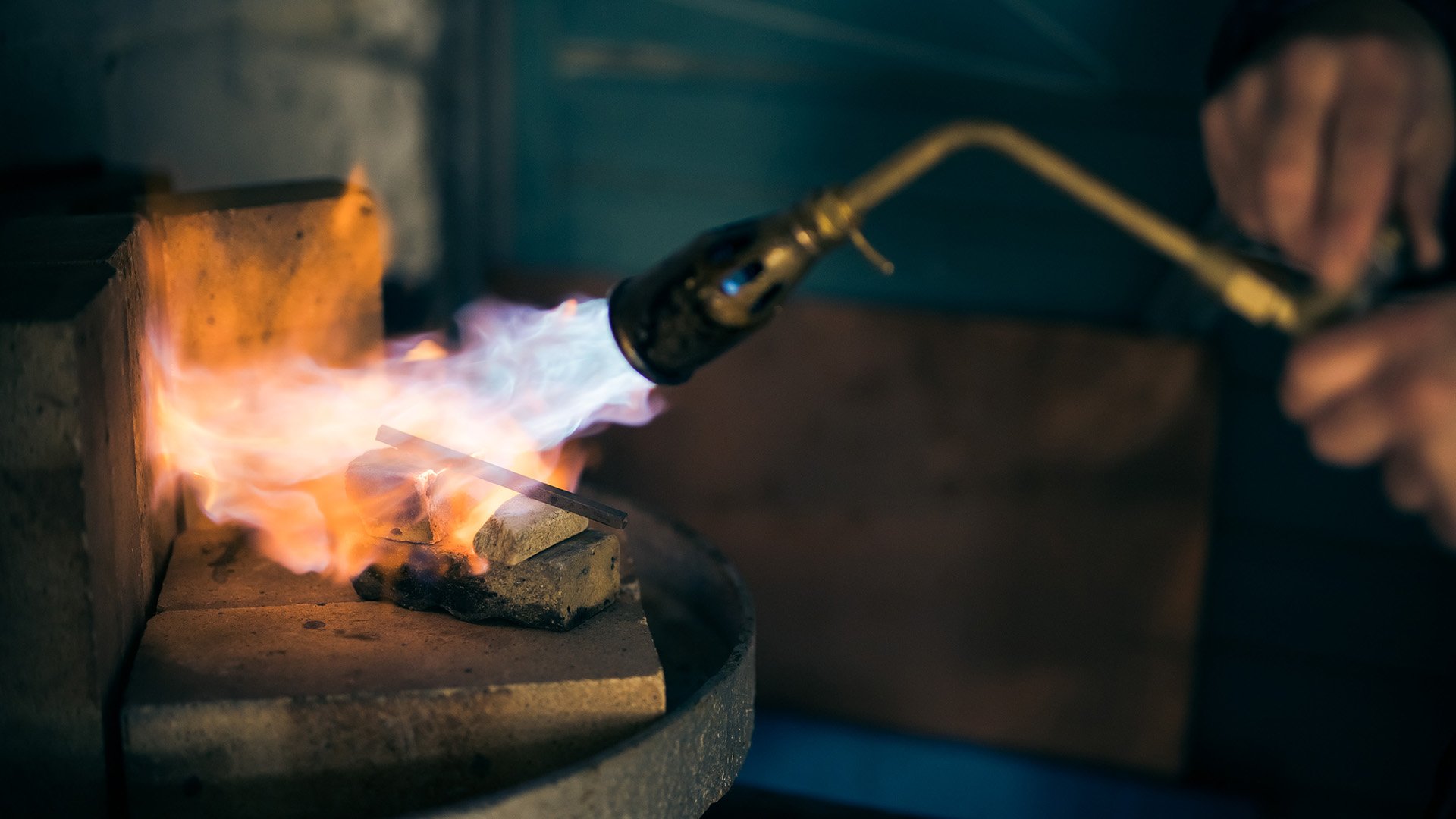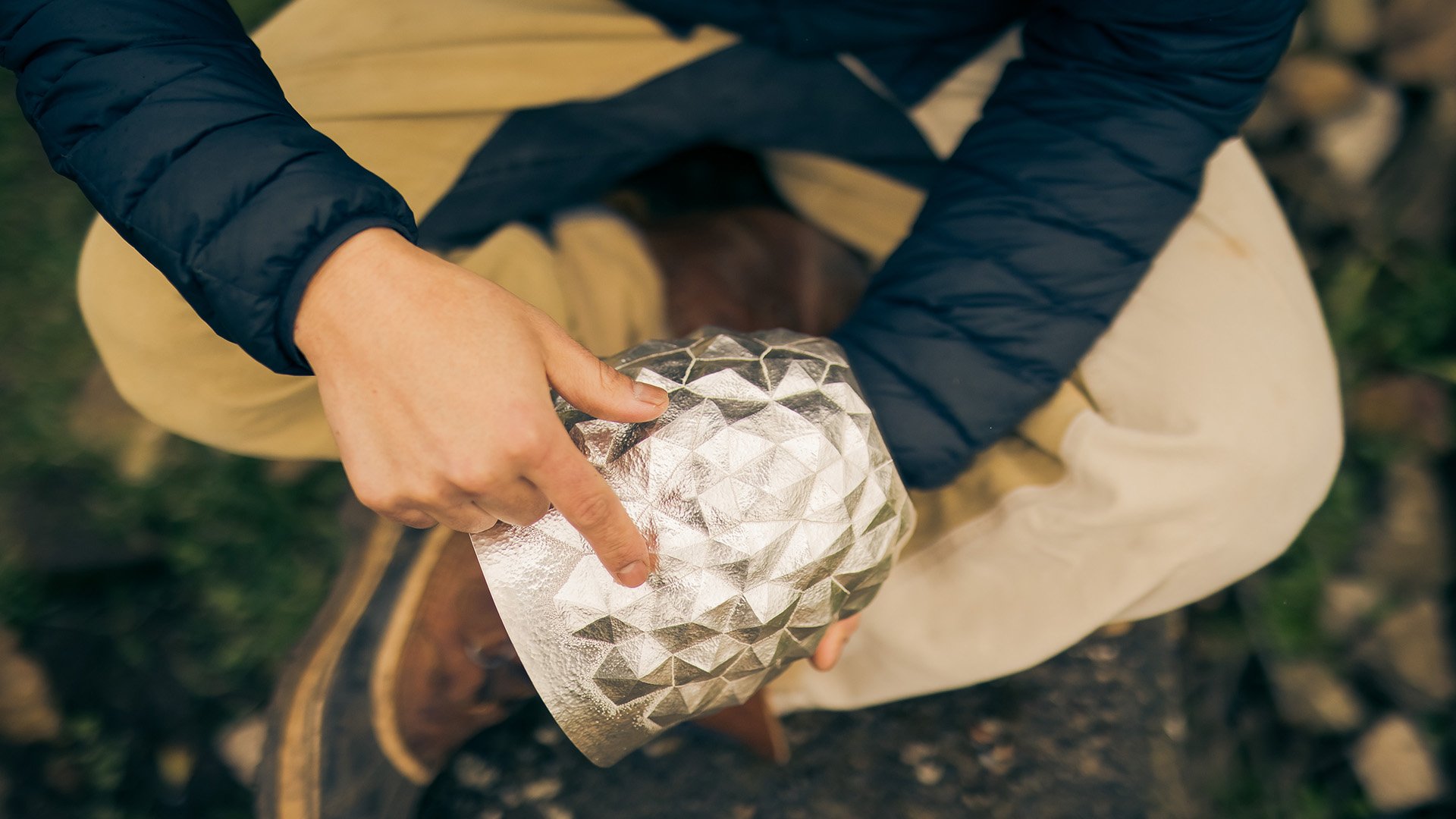Intricate surfaces: the silver of Yusuke Yamamoto
“Small elements of inspiration form layers in my head and sometimes connect together to become a story that I translate into silver.” For Goldsmiths’ Stories, Kate Youde speaks with Japanese Silversmiths Yusuke Yamamote about using everyday observations and sensory experiences to tell stories with silver.
Yusuke Yamamoto likes to tell himself stories. “Some percentage of my brain is always thinking about my work, looking for a new idea,” says the Japanese silversmith. “Small elements of inspiration formlayers in my head and sometimes connect together to become a story that I translate into silver.”
Yamamoto’s work – eye-catching sculptural vessels and beakers that display his skill for chasing – is what he has previously called “a manifestation of my everyday observations”. These could be the scent of something carried on the wind during a walk in the woods, the look of trees moving in the breeze or the sound and rhythm of shaking branches and leaves.“I use all of my senses to catch what I feel,” he says. An idea could also come while he is watching a film or reading a book. “Everything is inspiring.”
It helps that he lives in a scenic part of the world, a remote spot in the Llŷn Peninsula where north Wales juts out into the Irish Sea. He is a 10-minute drive from his favourite part of the coastline, at Porth Ysgaden, while Snowdon is an hour away. During the Covid lockdowns he used the inspiration on his doorstep – the hedgerow leaves and banks of flowers lining the country lane to the front, the birds visiting his “quite wild” garden at the back, and the hill that would be clearly visible across the fields on a less dreary day than the one on which I visit to hear him tell his own story.
A child who loved making, Yamamoto majored in metalsmithing at Musashino Art University in Tokyo before working as a Research Associate in its Department of Industrial, Interior & Craft Design. He swapped steel for silver after working with Japanese master silversmith Hiroshi Suzuki, who was teaching at the university as a professor. Suzuki’s work is held in collections at the Victoria & Albert Museum and the Goldsmiths’ Company.
However it was the Scottish engraver Malcolm Appleby who Yamamoto says inspired him to think that making a living in the UK as a full-time silversmith was possible. A few years after completing a stint as artist in residence at Glasgow School of Art, Yamamoto spent five days with Appleby at his workshop in Aberfeldy for a Goldsmiths’ Company Master Craftsman internship in 2015. On his return to Japan he couldn’t find a market for his silversmithing and was drawn to rural Wales by an offer of work from his friend, Japanese artist and metalworker Junko Mori, in 2016.
Yamamoto’s wife, jeweller Satoko Takemura, now works two days a week for Mori, who lives a short drive away. Takemura also makes her own designs from a workshop at the front of the home the couple share with their three-year-old daughter and Peat, the ageing border collie they brought with them from Japan, who “doesn’t have any interest in sheep”.
Yamamoto’s own workspace is a separate converted breeze-block garage to the rear of the property. Here he has two work benches: one displays some of his works in progress, while the other is for making, with the tools of his trade – most of which he makes himself – within easy reach. Tin cans containing different chasing punches sit on this bench, while hammers hang in a line above and from a board to the side. Yamamoto’s largest piece to date – a commissioned 2.8kg vessel, Dappled Garden – is set into pitch on a specially made stand, to stop it from moving when he chases.
His elaborate designs start out as a circular sheet of Britannia silver, which he raises by hammer to create the bowl shape of a vessel or beaker. To do this, he heats the metal with a blow torch to make it more malleable – a process calling annealing – before quenching it with water to cool it. He then takes it to a stake, around which he raises the silver, little by little, by hammering out from the centre in concentric circles. Every time the silver hardens, he returns to the burner to soften it again.
He likes to start cold winter mornings with hammering “to heat up myself and then start chasing”. He discovered that he cannot turn on any heating in his workshop because it will make his steel stakes humid and more prone to rust. Instead he wraps up in layers and “North Pole” boots.
Once he has his desired “canvas”, he pours pitch – made from either bitumen or (less smelly) pine resin – inside the vessel or beaker. This holds the shape of the silver while he is chasing – a technique that involves him pressing different shapes and sizes of steel punches into the surface of the metal to create patten and texture.
After he has sketched out a design on paper, he copies it on to his shaped silver with pencil and pen. Depending on the piece, he might start by chasing the outline of his design before making the 3D shape, “the sculpture on the surface”. He heats the pitch inside a piece with a heat gun – like a strong hairdryer – when he is chasing to make the silver easier to work with.
When his design is complete, he heats and pours out the pitch, which can be reused, and cleans the inside of the piece with white spirit. He removes his drawing marks from the surface with acetone, cleans the silver and polishes only the rim.
Some of his silverware features gold in places, drawing on the inlay technique nunome zōgan that resembles a woven fabric. For this, he uses a chisel to cut the surface of the silver and then a bamboo punch to squash gold foil into the grooves.
Yamamoto is now 44, and his style has changed “little by little” over the years as his skills have progressed, most recently incorporating techniques he learned during a five-day online course with silversmith Rod Kelly in 2021. The stories Yamamoto devised for himself used to lead to quite abstract designs, such as the Sweet Squama vessel (2014) – one of three of his pieces in the Goldsmiths’ Company Collection – which was inspired by, but is not necessarily recognisable as, a durian fruit. However, identifiable motifs, including ivy and gorse, started creeping into his work about three years ago and now designs such as his Daffodil vessel (2021) are closer to life.
“I’m showing the daffodil but also the grass movement,” he says. “The front leaf and the back leaf are different colours and textures, so I want to show that by using different textures with my chasing, and give movement to try to capture seeing one day of the flower. The smell and sound of the flowers, grass, soil and rain are brought by the wind in my image.” His next piece might feature “not so complete a motif”, as he is considering a “quite selfish design” that combines his own initials with this year’s Y date letter hallmark.
Whatever the intention behind them, all Yamamoto’s designs involve chasing patterns and textures onto silver, creating intricate surfaces that have an enthusiastic following amongst those who appreciate his combination of artistry and craftsmanship, including visitors to Goldsmiths’ Fair. A typical piece is built up from at least 10,000 individual punch marks and can take months to complete. “I like tapping all day,” he says, and he may well continue doing so for many years to come. “To keep living as a full-time artist silversmith is my dream.”
Written by Kate Youde | Photography by Paul Read
This Goldsmiths’ Story was first published in the Goldsmiths’ Review 22-23









